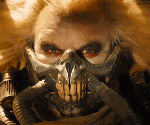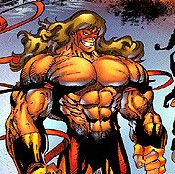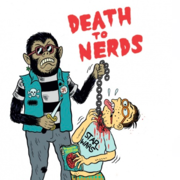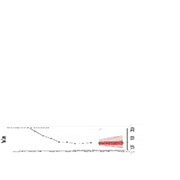|
I needed to be either or. It tried to be a new story that aped a bunch of scenes and characters from previous material.
|
|
|
|

|
| # ? Apr 24, 2024 16:57 |
|
Snak posted:I needed to be either or. It tried to be a new story that aped a bunch of scenes and characters from previous material. I think this is the weirdest thing for me. While watching the anime for the first time I was seeing all these identical scenes (but better executed in a lot of ways) but the plot beats they were attached to were different or meatier. I can't think of anything similar to this that is an adaptation of other visual media without being a straight transposition to a western setting in order to capture that audience. So much of the movie is the same/homage (whatever people want to call it, I'm not a film student) that it actually makes it more jarring than just a total new story with the same characters or whatever. That being said, having not seen the source material I thought the movie was watchable, just nothing exciting because it didn't delve deeply enough into the robot poo poo and the action was not amazing (although it had cool moments).
|
|
|
|
Snak posted:And this isn't a subversion. This is loyalty to the source material. In the film and the anime series, Section 9 is is explicitly and extra-legal fascist organization. Their job is explicitly to kill people who are inconvenient for the state. That's literally why The Major turns invisible in the iconic scene. She's assassinating someone with diplomatic immunity, because "it's the right thing to do". Exactly; people are somehow confused as to why the fascist character who is literally programmed to defend the white race, is white. starkebn posted:I don't understand the objection to critiquing this as an adaption when so much of the material is directly adapting previous works. The film does not directly adapt anything. Again, adaptation is simply translation into another medium. For example, the ellipsis at the end of this sentence might be translated as a fade-to-black if my post were adapted into a short film.... But if I write an entirely different sentence that also has an ellipsis... we would not call this a 'direct adaptation' of the previous ellipsis. These are entirely different sentences that simply refer back to the previous sentence, and complement it. This Ghost In The Shell makes references to the 1995 film, but the modification and recontextualization of the imagery changes its meaning entirely. Remember, it goes from being the story of the birth of an antichrist to the story of the death of a proto-Christ. A translation of the New Testament that omits the Jesus character is obviously not a translation at all. And what is Ghost In The Shell 1995 without its 'puppetmaster' villain?
|
|
|
|
You're only looking at the deeper meaning of the film and neglecting to consider the surface level, which is just as important. It doesn't just make references to 95, it copies most of the major set pieces and characters, only changing the context they are presented in while leaving the actual scenes more or less unchanged. It's more complicated than just using an ellipsis in two sentences. I think calling it an adaptation is more than fair, even if it pulls from multiple sources and recontextualizes it. I think it's also fair to say that it also explores a lot of the same themes as 95, only really changing the conclusion that it eventually comes to with regard to regaining her humanity rather than transcending it, more a of a twist on the original rather than an entirely new idea, which isn't unheard of in adaptations.
|
|
|
|
tweet my meat posted:You're only looking at the deeper meaning of the film and neglecting to consider the surface level, which is just as important. It doesn't just make references to 95, it copies most of the major set pieces and characters, only changing the context they are presented in while leaving the actual scenes more or less unchanged. It's more complicated than just using an ellipsis in two sentences. I think calling it an adaptation is more than fair, even if it pulls from multiple sources and recontextualizes it. In dismissing/ignoring the formal qualities of the work and asserting that the characters remain unchanged whatever the nuances of their presentation, you are insisting on the notion of a 'deep' essence that dwells perhaps even literally beneath the surface of the screen. Instead of performing the act of reading, you deliberately prevent comprehension by retreating into insistence on (your) 'complexity'. That is pretension. Counter to that pretension, I am dealing in such basic things as whether the boat scene takes place at daytime or at night. 1995's Motoko dives not because she enjoys being underwater, but specifically because she enjoys the act of resurfacing into sunlight. 2017's Mira is the polar opposite; she dives at night. There is no essence. Simply changing the time of day in one scene has altered the character entirely. Of course the movie is about this fact.
|
|
|
|
SuperMechagodzilla posted:1995's Motoko dives not because she enjoys being underwater, but specifically because she enjoys the act of resurfacing into sunlight. 2017's Mira is the polar opposite; she dives at night. In the original she dives because if her flotation device fails she would sink and be hosed, so it is risk taking behaviour that makes her feel vulnerability. In the new film she dives because she did it in the original. e: no , that's unfair, in the new film she does it to get away from the incessant digital signals. Still, in the original the Major comes across as a depressed "who am I? what am I doing?" and the dive is very much like trying to feel something. Also the boat trip through the city is trying to be amongst the rest of the world, to connect. In the new film I guess she is more PTSD? I am not really familiar with that so I'm not sure if that's right but the whole repressed memories / flashbacks thing certainly makes her a different character. Which isn't a bad thing, just not something I enjoyed as much. starkebn fucked around with this message at 00:45 on Aug 9, 2017 |
|
|
|
starkebn posted:In the original she dives because if her flotation device fails she would sink and be hosed, so it is risk taking behaviour that makes her feel vulnerability. In the new film she dives because she did it in the original. The risk-taking aspect of the dive is just the warm up for Motoko's surrepetitious reenactment of her (re)birth. She literally dreams of being born again, so the destruction of her body at the end is very clearly something she has been building towards. In 2017, on the other hand, we are given multiple scenes of Mira being repaired - her gunmetal innards being re-coated in artificial flesh. So the point is again entirely different: Mira does not long to escape her body, but instead goes through an arc where she embraces her identity as a robot - instead of hiding from it, underwater. The exposure of her innards is actually best read as a celebration of her new embodiment. This is the point of the jellyfish imagery that was not present in the 1995 film. Mira's desire to 'disconnect' is a return to nature, and an artifact of her previous existence as an ineffectual Luddite. She cannot float freely among the weeds; the 'jellyfish' needs a body. So we return to the imagery from the credits, of the jellyfish-brain wrapping its tentacles around a spinal cord in a tight embrace. Of course, the idea that 'the mind cannot exist without a body' is very basic stuff, but film has thoroughly established a unique and troubling definition of 'body' - one where the evil CEO is defined as a part of Major's body, and she can therefore consent to his removal.
|
|
|
|
I just got done watching the live action movie, having (re)watched the anime a couple days ago. I liked the live action version a LOT more than I expected to. I'm pretty okay with it not being a strict adaptation of the 95 movie, and I see it more of a different story using some similar characters. I don't see it as particularly dissimilar (or any more offensive) than "Stand Alone Complex" or "Arise", both of which did essentially the same thing. The movie was gorgeous, though. The world it depicted was borderline-scary with how pervasive the technology and cybernetic enhancements were, and I really dug it. It sort of approached that "sensory overload" threshold for me without ever crossing it.
|
|
|
|
I'm here because I saw the live action film. It's was good cyberpunk. I had heard of the original, and now really want to follow it up. The film was a visual treat, the storyline wasn't convoluted, and i loved the themes it explores.
|
|
|
|
IMO the action scenes in the anime were better done, particularly the chase with the guy on foot and the fight with him in the water amongst ratty old buildings. It was far more stylish in the animation. https://www.youtube.com/watch?v=JkvRVkaE6y4 vs https://www.youtube.com/watch?v=90OX7x7KeVE
|
|
|
|
Olympic Mathlete posted:IMO the action scenes in the anime were better done, particularly the chase with the guy on foot and the fight with him in the water amongst ratty old buildings. It was far more stylish in the animation. Here's another thing, in the 95 version the fight is extreme violence separated by pauses to see if that was enough. The violence is a means to an end. The 2017 one by contrast, doesn't go as far with the level of violence, but ups the brutality by having the Major just whale on the dude with no pauses. He's crawling on the ground and she's just working him over. It's both less interesting visually and doesn't fit with the ice cold professional characterization.
|
|
|
|
You cannot begin with the assumption that the scenes are fundamentally the same and conclude from that that the differences are 'merely cosmetic'. The differences are the characterization. Again, the 1995 fight scene exists purely to foreshadow the end of the film, when Puppetmaster gains control of Batou's arm.  Batou takes out the spider-tank the way Corgi destroys the police van, then their arms both get restrained by invisible forces. They even wear similar gloves, to underline the association. The point of the film is that even Batou is treated as expendable garbage, clinically and dispassionately stripped of his agency - yet he still enables Motoko's transformation into an antichrist out of his unrequited love for her. In the 2017 film, Batou does not show up at the end. The fight scene, instead, foreshadows Kitano's execution of the CEO character (who, you might recall, is knocked backwards into a pool of water, generating a symmetrical wake).  The point here is that the garbageman was never the real enemy. Motoko's flurry of violence is hurricane imagery (note that the character never removes his raincoat, and there is far more water splashing about), and is replaced at the end with her simply consenting to a quick execution performed by someone else. She's no longer motivated by simple anger. This is a character arc.
|
|
|
|
Olympic Mathlete posted:IMO the action scenes in the anime were better done, particularly the chase with the guy on foot and the fight with him in the water amongst ratty old buildings. It was far more stylish in the animation. Yeah that scene didn't have the same kick at all in the live action version. Same with the spider tank scene.
|
|
|
|
I really didn't like how in the 2017 film, they showed the villain taking direct control of the spider tank. In the original, it's one piece of military hardware against another. Since a central question for The Major is whether she's really a person or just a weapon, the battle in the original movie is framed as conflict between a completely soulless weapon, and one who's wondering if she is. When the spider tank's guns wipe out the mural of the tree of life, it represents erasure of origin, and the idea that the origin of The Major doesn't matter, because she can choose what she wants to be. It doesn't matter where she or the puppet master came from, because they choose a new destiny. Obviously none of that applies to the new film and it's just a worse version of chappie's final fight against a villain remote controlling a giant robot.
|
|
|
|
Snak posted:In the original, it's one piece of military hardware against another ... a completely soulless weapon, [not] a villain remote controlling a giant robot.   You need to be careful.
|
|
|
|
Snak posted:I really didn't like how in the 2017 film, they showed the villain taking direct control of the spider tank. In the original, it's one piece of military hardware against another. Since a central question for The Major is whether she's really a person or just a weapon, the battle in the original movie is framed as conflict between a completely soulless weapon, and one who's wondering if she is. When the spider tank's guns wipe out the mural of the tree of life, it represents erasure of origin, and the idea that the origin of The Major doesn't matter, because she can choose what she wants to be. It doesn't matter where she or the puppet master came from, because they choose a new destiny. Also in the '95 film the Puppetmaster's stooge in the garbage truck does his bidding because his memories have been ghosthacked and he thinks his actions are going to help him be reunited with a daughter who never actually existed. His brain has been swiss-cheesed but he's still acting independently, happy to go along with the plan. When the truth of the matter is revealed and we discover that the Puppetmaster mindraped a random innocent citizen just so he'd perform a menial task it's horrific. Corgi (the guy the Major fights in the canal) had also been ghosthacked but he turns out to have been a minor thug who was prone to violence already. In the '17 film Kuze just takes control of the bodies of the garbage collectors and operates them remotely like they're characters in a video game, turning them into murderous automatons against their will. Corgi and the garbage truck driver are rolled into the same character. It's a heck of a lot blunter than the '95 version and there's no longer any real reason for Kuze to have given the garbage collector all those false memories, especially since they removed the scene where they explain to the driver that his original memory may never be restored and he'll probably experience residual simulations for some time and instead added that to the Major's character arc. Also Section 9 beat the poo poo out of and then aggressively interrogate an innocent man and then barely react when Kuze forces him to commit suicide as opposed to the '95 film where they gently question him with pity and empathy and then he's presumably left to pick up the pieces of his ruined life.
|
|
|
|
The spider tank fight was a lot better in 95. I loved how serene the whole scene felt with the great score and the moments of calm interspersed with gunfire.
|
|
|
|

|
| # ? Apr 24, 2024 16:57 |
|
Snowglobe of Doom posted:Also in the '95 film the Puppetmaster's stooge in the garbage truck does his bidding because his memories have been ghosthacked and he thinks his actions are going to help him be reunited with a daughter who never actually existed. His brain has been swiss-cheesed but he's still acting independently, happy to go along with the plan. When the truth of the matter is revealed and we discover that the Puppetmaster mindraped a random innocent citizen just so he'd perform a menial task it's horrific. Corgi (the guy the Major fights in the canal) had also been ghosthacked but he turns out to have been a minor thug who was prone to violence already. As with the spider-tank, that is not actually what happens in the films. The spider-tank has a human pilot, and his white helmet is made to resemble the design of Motoko's cyborg brain (which are literally a chunk of human brain tissue encased in a metallic shell). The Puppetmaster theorizes that the tank lost the fight because it had a human pilot. That's why we have a very deliberate close-up on his face when the Puppetmaster says "your desire to remain what you are is what ultimately limits you." The tank is killed specifically because it has a human soul - because it's "too human". Of course, both ignore that it was Batou who saved them. As a contrast, the spider-drone in 2017 is 'just a soulless puppet' - literally has a big gap where the human pilot should be. But the point is that, like the Geisha-bot, Mira feels a sort of kinship with it. She attempts to free it from the control of the villain. This is the exact opposite of what Snak claims happened. When the suspect is interrogated in the 1995 film, the repeated "sorry" from the interrogator is explicitly cold comfort. It's not gentle questioning. It's a harsh but routine interrogation, because they are very familiar with this ghost-hacking thing and they want to just cut to the chase. 'Sorry about your family, but we have important work here.' In the 2017 film, mind control is a new phenomenon, and they think they can brute-force their way through the false memories. Then it's revealed that Kuze has used the lie-detector as a gateway to sneak into the interrogation room. The garbage-man was not being remote-controlled. He was acting according to false memories, just like in the 1995 film. The 2017 film simply adds a third layer to the character's mind: beneath both the false memories and the real memories, you have this boiling abstract collective rage. SuperMechagodzilla fucked around with this message at 01:07 on Aug 13, 2017 |
|
|















